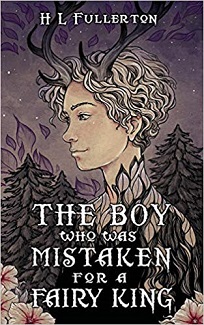 The Boy Who Was Mistaken for a Fairy King
The Boy Who Was Mistaken for a Fairy King
by
H. L. Fullerton
(Annorlunda Books, November 13, 2019, pb, 54 pp.)
Reviewed by Tara Grímravn
Carl King was born with an unusual physical feature—antlers. This didn’t stop him from fitting in, however. Far from it. Although he can talk to trees and fairies often leave him gifts, Carl’s a popular, handsome boy who’s now caught the eye of Evangeline Chase, the daughter of a fervent hunter. One evening, while in the middle of a date, Evangeline’s Jeep breaks down and the pair find themselves surrounded by gremlins, who offer to fix it. While the little creatures work on the car, they ask Carl if he’s going to call for the Hunt, saying that they’ll be his soldiers when he does. Confused, he tells them he’ll let them know should he decide to do so. It soon becomes clear on the night of the winter formal, however, he’s been the victim of a terrible case of mistaken identity, placing himself and his friends in grave danger.
The writing style that Fullerton uses in this story has a very particular feel to it that I found quite enjoyable. It has the ring of a classic children’s story, almost as though one were reading something akin to Lewis Carroll’s Alice’s Adventures in Wonderland but written with a far more modern sensibility. The cadence is both poetic and lyrical, and quite lovely. Adding to this experience is the author’s use of third-person omniscient narration, including the interjections which explain various bits and bobs mentioned, like the iconography of crocuses and deer. This gives the distinct impression that the reader is being told the story by an actual person and not just reading it for themselves. The effect is something similar to that found in J. R. R. Tolkien’s The Hobbit, where the narrator comments on the events unfolding in the story.
Still, as nice as this effect is, these breaks from the storyline do occur quite frequently in Fullerton’s story (a habit from which Tolkien himself suffered) and, while they do provide some nice commentary and humorous insight into what’s happening, they can be a bit distracting. For example, in the first few pages, there’s one after each paragraph. As one gets deeper in, they appear less and less often but are still sprinkled in rather heavily and become somewhat tedious to read after a while. I found myself either skimming through them or skipping them altogether.
Overall, though, Fullerton’s story is a good read for a few reasons. First, the premise of a boy being mistaken for a fairy king is interesting and fairly novel. Also, it deserves mention that this take on the Wild Hunt of folklore is most certainly original. Finally, the twist is something that the reader won’t see coming too early on.